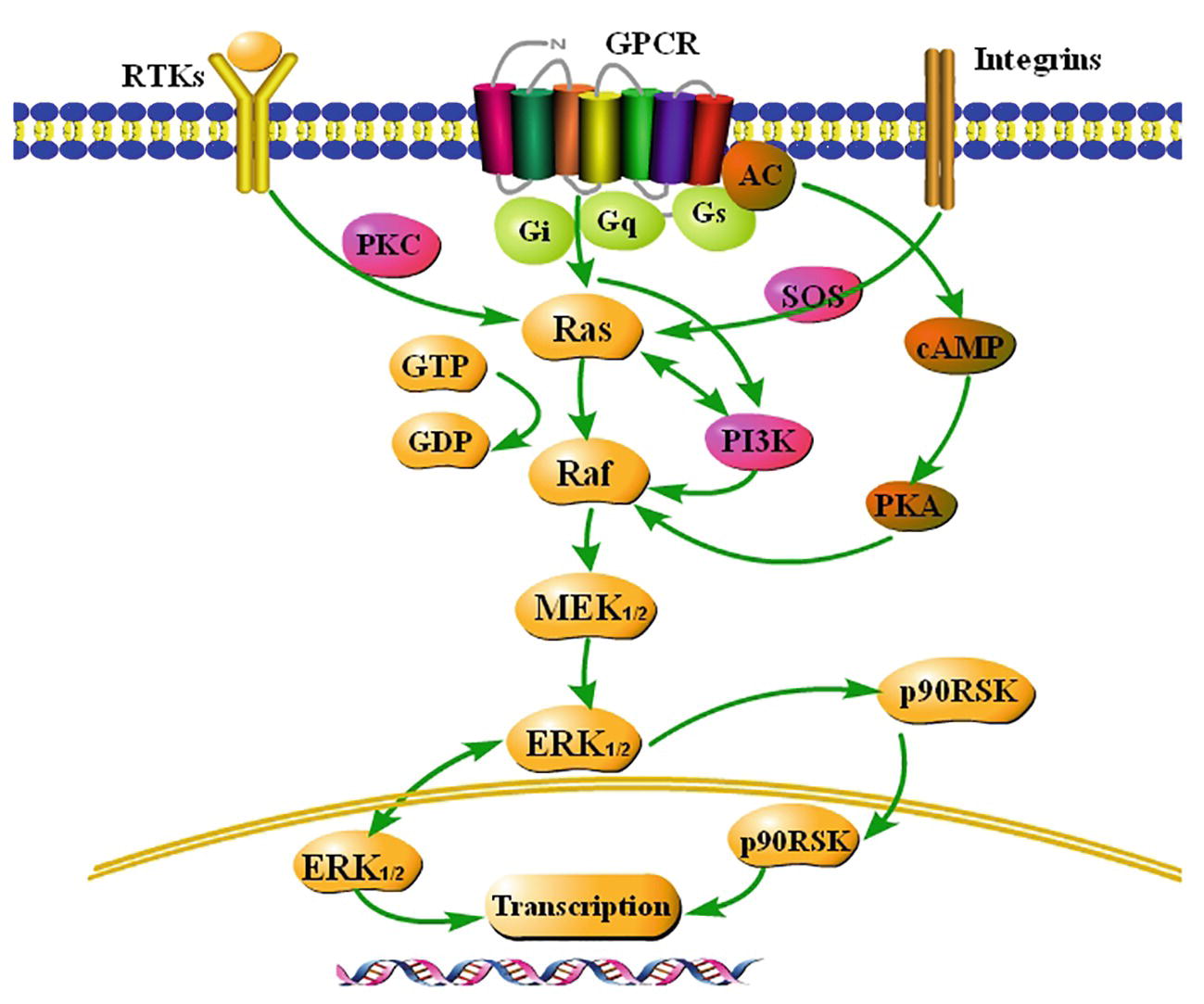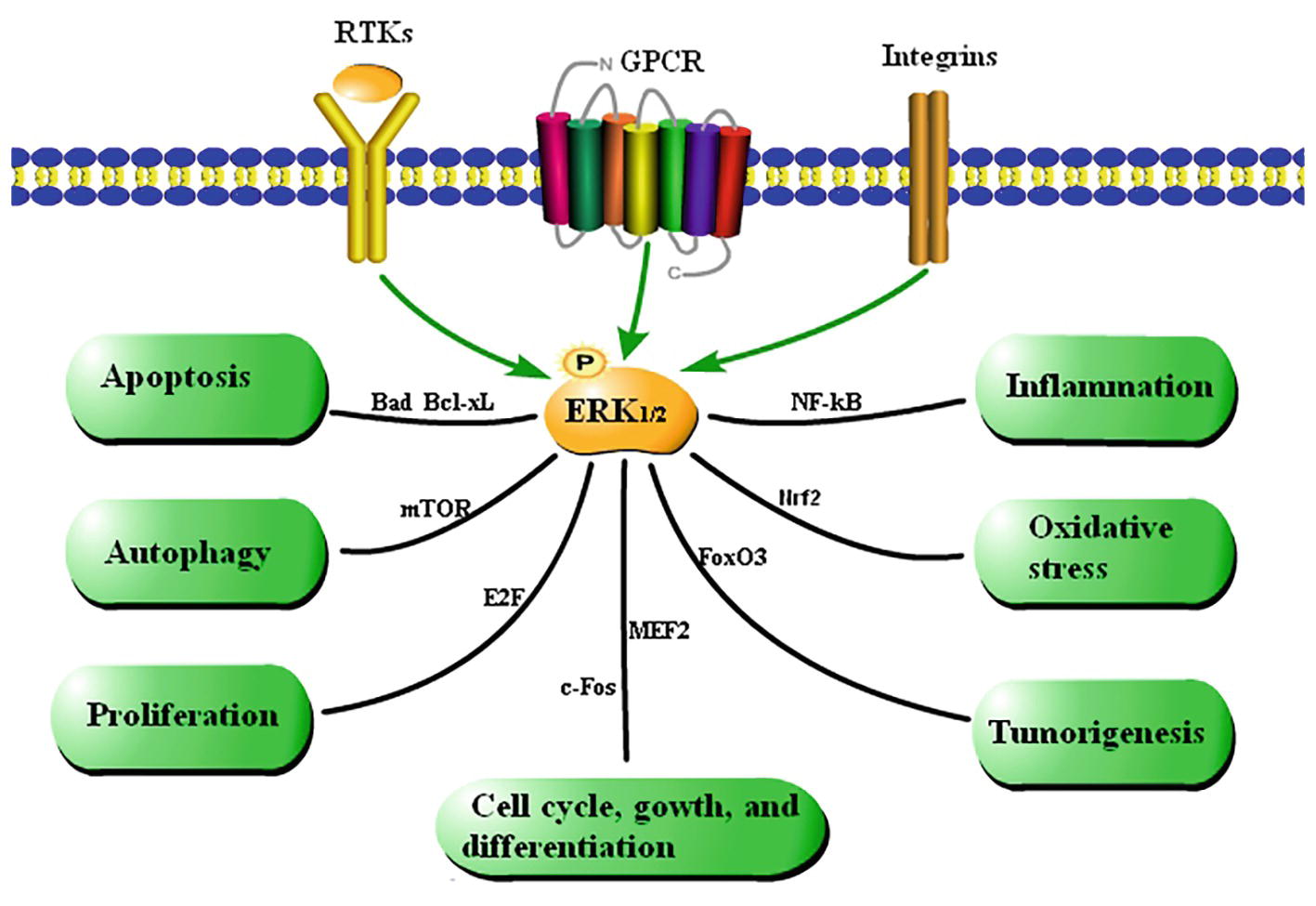ERK (Extracellular Signal-regulated Kinases)
Related Symbol Search List
Immunology Background
About ERK (Extracellular Signal-regulated Kinases)
Extracellular signal-regulated kinases (ERKs) are members of the mitogen-activated protein kinase (MAPK) family of signaling molecules. In molecular biology, extracellular signal-regulated kinases (ERKs) or classical MAP kinases are widely expressed protein kinase intracellular signaling molecules that are involved in functions including the regulation of meiosis, mitosis, and postmitotic in differentiated cells.
ERK is generally located in the cytoplasm; upon activation, ERK enters the nucleus and regulates transcription factor activity and gene expression. ERK exists in two main forms, ERK1 (p44) and ERK2 (p42). There are also several atypical forms of ERK, including ERK3, ERK4, ERK5 and ERK6. ERK1 and ERK2 are two important members of the MAPK/ERK pathway, with molecular weights of 44 and 42 kDa, respectively. The C-terminus of ERK5 contains a nuclear localization signal (NLS), two proline-rich regions, and a transcriptional activation domain (TT). The C-terminus of ERK5 contains a nuclear localization signal (NLS), two proline-rich regions, and a transcriptional activation domain (TAD). ERK5 is more than twice the molecular weight of other MAPKs (110 kDa). This structural difference enables active ERK5 to self-phosphorylate its C-terminal TAD, which is a unique ability of ERK5 to directly control its gene transcription.
ERKs play key roles in several cell signaling pathways and are involved in the regulation of biological processes such as cell proliferation, cell differentiation, cell migration, cell survival apoptosis, etc. ERKs transmit signals from external stimuli and regulate cellular physiological responses by regulating the phosphorylation status of transcription factors, cell cycle proteins, and other downstream effector proteins. (Many different stimuli, including growth factors, cytokines, virus infection, ligands for heterotrimeric G protein-coupled receptors transforming agents, and carcinogens, activate the ERK pathway.)
Mechanism of Action of ERKs
The ERK/MAPK signaling pathway is central to the signaling network involved in the regulation of cell growth/development/division. The ERK pathway is activated by a variety of stimuli including growth factors, cytokines, viruses, G protein-coupled receptor ligands, and oncogenes. Key molecules in the ERK/MAPK signaling pathway include the small G-protein Ras and the downstream Raf kinases, MEK1/2 and ERK1/2. Ras is the most conserved product encoded by the Ha-ras, Hi-ras, and N-ras oncogenes of the ras gene family. Raf kinase is a product of the Raf oncogene. MEK1 and MEK2 are rare bispecific kinases that activate ERKs by phosphorylation at two regulatory sites (Tyr 204/187 and Thr 202/185).
Regulation of ERK activity mainly involves a balance between phosphorylation and phosphatase. ERKs are phosphorylated during activity regulation and transmit signals by phosphorylating downstream target proteins. The activity of ERKs is triggered by external stimuli that activate downstream signaling pathways by activation of receptors on the cell membrane, which ultimately leads to the phosphorylation of ERKs. After activation, ERKs can enter the nucleus or cytoplasm and interact with various transcription factors and cell cycle proteins to regulate gene expression and cell function.
 Fig.1 Summary of the classical Ras-Raf-MEK-ERK1/2 signaling pathway. (Kong T, et al., 2019)
Fig.1 Summary of the classical Ras-Raf-MEK-ERK1/2 signaling pathway. (Kong T, et al., 2019)
Extracellular signals stimulate G-protein-coupled receptors (GCPRs), receptor tyrosine kinases (RTKs), and integrins on the membrane, and activate ERK1/2, a key signaling molecule, via a series of cascade reactions. ERK1/2 is usually located in the cytoplasm. Once activated, ERK1/2 rapidly crosses the nuclear membrane, reactivates transcription factors, regulates transcription of target genes, induces expression or activation of specific proteins, and finally regulates cellular metabolism and function.
Functions of ERKs
- Regulation of Cell Proliferation and Differentiation
ERKs are involved in the regulation of the cell cycle, ensuring that cells proliferate and differentiate in the correct order. They regulate the activity (transcription, translation, and degradation) of cell cycle protein-dependent kinases (CDKs) and cyclins, controlling cell cycle progression and cell proliferation.
- Cell Migration and Invasion
ERKs regulate cytoskeletal reorganization and phosphorylation of cell adhesion proteins, which are important for cell migration and invasion. They are involved in extracellular matrix degradation, regulation of intercellular junctions, and control of cell motility.
- Cell Survival and Apoptosis, Autophagy
ERKs are involved in regulating the expression of apoptosis-inhibitory proteins and apoptosis-inducing proteins, modulating the balance between cell survival and apoptosis. Many studies have shown that the Ras-Raf-MEK-ERK1/2 signaling pathway initiates autophagy by upregulating the expression of autophagy marker proteins LC3 and p62 under stress conditions. On the other hand, this signaling pathway also inhibits autophagy by down-regulating the expression of lysosome-associated membrane proteins, thus preventing the fusion of autophagosomes with lysosomes.
- Disease Regulation
Abnormal activity of ERKs is associated with the onset and progression of a variety of diseases. They are involved in tumorigenesis and metastasis, pathogenesis of neurological diseases (e.g., Parkinson's disease, Alzheimer's disease), and so on. For example, aberrant activation of the Ras-Raf-MEK-ERK1/2 signaling pathway leads to aberrant activation of downstream signaling components. This will affect the apoptosis and differentiation of normal cells and promote their malignant transformation and abnormal proliferation, leading to tumorigenesis. Therefore, ERKs become important targets for research and drug development.
 Fig.2 Summary of the functions of the ERK1/2 signaling pathway. (Kong T, et al., 2019)
Fig.2 Summary of the functions of the ERK1/2 signaling pathway. (Kong T, et al., 2019)
Cytokines regulate cellular processes via the ERK1/2 signaling pathway. Extracellular stimulation leads to phosphorylation of ERK1/2, which affects various cellular activities by mediating activation of transcription factors.
Available Resources for ERKs
Creative BioMart is dedicated to providing the scientific community with high-quality products, such as recombinant proteins, cell and tissue lysates, and protein pre-coupled magnetic beads, as well as customizable services and other resources to support your research in the field of ERKs. The following ERKs are displayed, click to view all related molecules/targets and research reagents. For further information or to purchase products, please contact our customer service team. Thank you for your interest in Creative BioMart and we look forward to providing you with excellent research support!
References:
- Kong T, Liu M, Ji B, Bai B, Cheng B, Wang C. Role of the Extracellular Signal-Regulated Kinase 1/2 Signaling Pathway in Ischemia-Reperfusion Injury. Front Physiol. 2019;10:1038.
- Lu N, Malemud CJ. Extracellular Signal-Regulated Kinase: A Regulator of Cell Growth, Inflammation, Chondrocyte, and Bone Cell Receptor-Mediated Gene Expression. Int J Mol Sci. 2019;20(15):3792.
- Guo YJ, Pan WW, Liu SB, Shen ZF, Xu Y, Hu LL. ERK/MAPK signaling pathway and tumorigenesis. Exp Ther Med. 2020;19(3):1997-2007.
